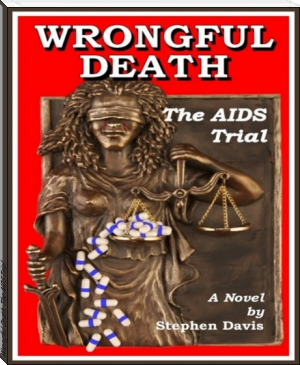Old Saint Paul's: A Tale of the Plague and the Fire, William Harrison Ainsworth [chapter books to read to 5 year olds TXT] 📗

- Author: William Harrison Ainsworth
Book online «Old Saint Paul's: A Tale of the Plague and the Fire, William Harrison Ainsworth [chapter books to read to 5 year olds TXT] 📗». Author William Harrison Ainsworth
"What can it mean?" cried Judith, as soon as she recovered her speech. "Are they human, or spirits?"
"Human beings don't generally amuse themselves in this way," returned Chowles. "But hark!—I still hear the music.—They are above—in Saint Paul's."
"Then I will join them," said Judith. "I am resolved to see the end of it."
"Don't leave me behind," returned Chowles, following her. "I would rather keep company with Beelzebub and all his imps than be alone."
Both were too well acquainted with the way to need any light. Ascending the broad stone steps, they presently emerged into the cathedral, which they found illumined by the same glimmering light as the lower church, and they perceived the ghostly assemblage gathered into an immense ring, and dancing round the tall skeleton, who continued beating his drum, and uttering a strange gibbering sound, which was echoed by the others. Each moment the dancers increased the swiftness of their pace, until at last it grew to a giddy whirl, and then, all at once, with a shriek of laughter, the whole company fell to the ground.
Chowles and Judith, then, for the first time, understood, from the confusion that ensued, and the exclamations uttered, that they were no spirits they had to deal with, but beings of the same mould as themselves. Accordingly, they approached the party of masquers, for such they proved, and found on inquiry that they were a party of young gallants, who, headed by the Earl of Rochester—the representative of the tall skeleton—had determined to realize the Dance of Death, as once depicted on the walls of an ancient cloister at the north of the cathedral, called Pardon-churchyard, on the walls of which, says Stowe, were "artificially and richly painted the Dance of Macabre, or Dance of Death, commonly called the Dance of Paul's, the like whereof was painted about Saint Innocent's, at Paris. The metres, or poesy of this dance," proceeds the same authority, "were translated out of French into English by John Lydgate, monk of Bury, and, with the picture of Death leading all estates, painted about the cloister, at the special request and expense of Jenkin Carpenter, in the reign of Henry the Sixth." Pardon-churchyard was pulled down by the Protector Somerset, in the reign of Edward the Sixth, and the materials employed in the erection of his own palace in the Strand. It was the discussion of these singular paintings, and of the designs on the same subject ascribed to Holbein, that led the Earl of Rochester and his companions to propose the fantastic spectacle above described. With the disposition which this reckless nobleman possessed to turn the most solemn and appalling subjects to jest, he thought no season so fitting for such an entertainment as the present—just as in our own time the lively Parisians made the cholera, while raging in their city, the subject of a carnival pastime. The exhibition witnessed by Chowles and Judith was a rehearsal of the masque intended to be represented in the cathedral on the following night.
Again marshalling his band, the Earl of Rochester beat his drum, and skipping before them, led the way towards the south door of the cathedral, which was thrown open by an unseen hand, and the procession glided through it like a troop of spectres. Chowles, whose appearance was not unlike that of an animated skeleton, was seized with a strange desire to join in what was going forward, and taking off his doublet, and baring his bony arms and legs, he followed the others, dancing round Judith in the same manner that the other skeletons danced round their partners.
On reaching the Convocation House, a door was opened, and the procession entered the cloisters; and here Chowles, dragging Judith into the area between him and the beautiful structure they surrounded, began a dance of so extraordinary a character that the whole troop collected round to witness it. Rochester beat his drum, and the other representatives of mortality who were provided with musical instruments struck up a wild kind of accompaniment, to which Chowles executed the most grotesque flourishes. So wildly excited did he become, and such extravagances did he commit, that even Judith stared aghast at him, and began to think his wits were fled. Now he whirled round her—now sprang high into the air—now twined his lean arms round her waist—now peeped over one shoulder, now over the other—and at last griped her neck so forcibly, that he might perhaps have strangled her, if she had not broken from him, and dealt him a severe blow that brought him senseless to the ground. On recovering, he found himself in the arched entrance of a large octagonal chamber, lighted at each side by a lofty pointed window filled with stained glass. Round this chamber ran a wide stone bench, with a richly-carved back of the same material, on which the masquers were seated, and opposite the entrance was a raised seat, ordinarily allotted to the dean, but now occupied by the Earl of Rochester. A circular oak table stood in the midst of the chamber, covered with magnificent silver dishes, heaped with the choicest viands, which were handed to the guests by the earl's servants, all of whom represented skeletons, and it had a strange effect, to behold these ghastly objects filling the cups of the revellers, bending obsequiously before some blooming dame, or crowding round their spectral-looking lord.
At first, Chowles was so confused, that he thought he must have awakened in another world, but by degrees he called to mind what had occurred, and ascertained from Judith that he was in the Convocation House. Getting up, he joined the train of grisly attendants, and acquitted himself so well that the earl engaged him as performer in the masque. He was furthermore informed that, in all probability, the king himself, with many of his favourite nobles, and the chief court beauties, would be present to witness the spectacle.
The banquet over, word was brought that chairs and coaches were without, and the company departed, leaving behind only a few attendants, who remained to put matters in order.
While they were thus occupied, Judith, who had fixed her greedy eyes upon the plate, observed, in an under-tone, to Chowles, "There will be fine plunder for us. We must manage to carry off all that plate while they are engaged in the masque."
"You must do it yourself, then," returned Chowles, in the same tone—"for I shall have to play a principal part in the entertainment, and as the king himself will be present, I cannot give up such an opportunity of distinguishing myself."
"You can have no share in the prize, if you lend no assistance," replied Judith, with a dissatisfied look.
"Of course not," rejoined Chowles; "on this occasion it is all yours. The Dance of Death is too much to my taste to be given up."
Perceiving they were noticed, Chowles and Judith then left the Convocation House, and returned to the vault in Saint Faith's, nor did they emerge from it until late on the following day.
Some rumour of the masque having gone abroad, towards evening a crowd, chiefly composed of the most worthless order of society, collected under the portico at the western entrance, and the great doors being opened by Chowles, they entered the cathedral. Thus was this sacred building once more invaded—once again a scene of noise, riot, and confusion—its





Comments (0)